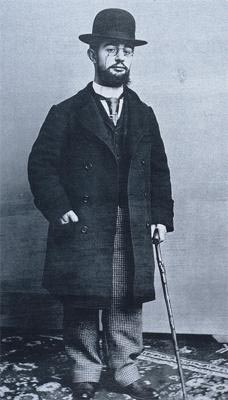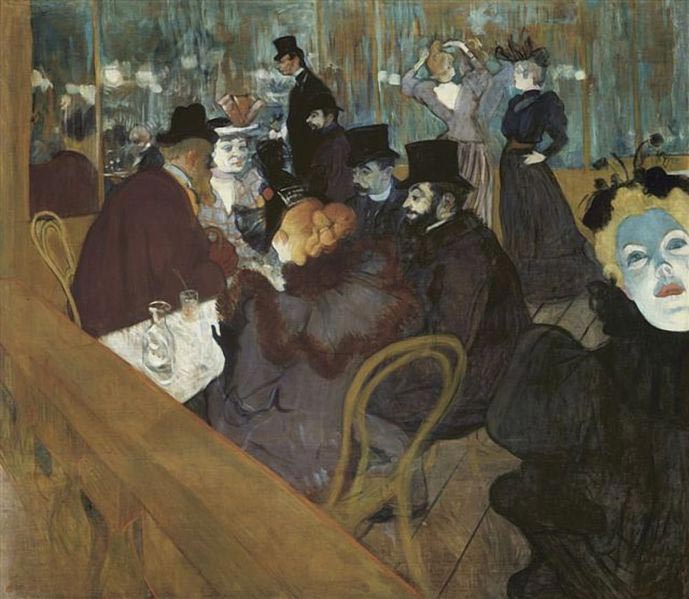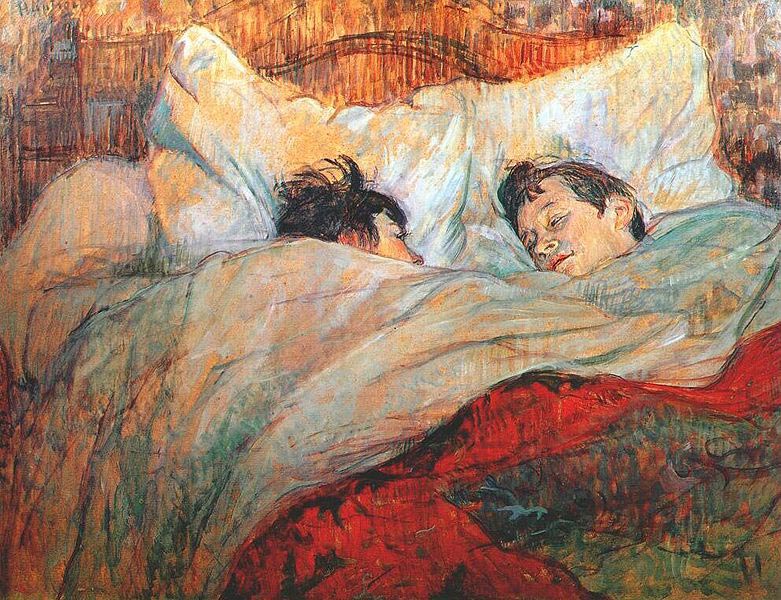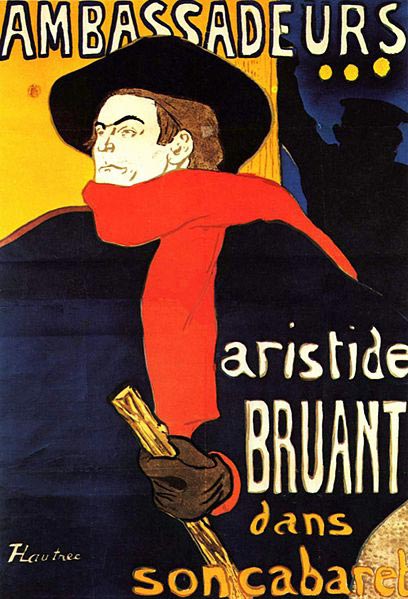| Henri De Toulouse-Lautrec | |
|---|---|
 |
|
| Born | Henri Marie Raymond de Toulouse-Lautrec-Monfa |
| Died | Nov. 24, 1864 Albi, Tarn, France |
| Nationality | French |
| Training | Rene Princeteau (informal) Léon Bonnat |
| Movement | Post-Impressionism, Art Nouveau |
| Field | Painter, printmaker, draftsman, illustrator |
| Famous Paintings by Henri de Toulouse-Lautrec | |
| In Bed: The Kiss, 1892 | |
| In Bed, 1893 | |
| Moulin Rouge: La Goulue, 1891 | |
| At the Moulin Rouge, 1892-1895 | |
| La Toilette, 1889 | |
| At the Moulin Rouge, The Dance, 1890 | |
| Complete Works |
Considered one of the most important painters in the post-Impressionist era in the late 19th century, Henri Marie Raymond de Toulouse-Lautrec-Monfa—simply known as Henri de Toulouse-Lautrec —chronicled the colorful, provocative and adventurous Parisian nightlife most commonly known and associated with the images of the Moulin Rouge club in popular culture today. Other famous French painters during the post-Impressionist creative period were Paul Cezanne, Vincent Van Gogh, and Paul Gauguin.
Toulouse-Lautrec was born on November 24, 1864 in the Midi-Pyrenees region of France, into the aristocratic family of Comte Alphonse and Comtesse Adele Tapie de Celeyran. They are descendants of the Counts of Toulouse and Lautrec, and the Viscounts of Montfa, which is a village in Southern France. He had a younger brother born in 1867, but the infant lived only for a year. Subsequently, his parents separated and the young Toulouse-Lautrec grew up under the care of a nanny. At 8 years old, he went to live with his mother in Paris, where he began a creative and artistic journey sketching caricatures in his workbooks.
His family took notice of this talent and even had a family friend Rene Princeteau give informal lessons. However, a congenital condition had started manifesting symptoms and burdening the young boy with physical and emotional difficulties. Toulouse-Lautrec was considered to have been suffering from various complications due to the fact that his parents were actually first cousins who had intermarried. Toulouse-Lautrec’s two grandmothers are actually sisters.
A bone dysfunction had led Toulouse-Lautrec to fracture his right and left thigh bones, at the ages of 13 and 14, respectively. The fractures did not also heal properly most possibly due to the genetic complications. His limbs apparently did not continue normal growth, such that Toulouse-Lautrec stood at a mere 1.54 meters or 5 feet 1 inches tall with an adult developed torso but almost child-like legs. It was purported further that the artist had hypertrophied genitalia.
 Henri de Toulouse-Lautrec’s mother sought cures for her son’s condition but to no avail, even taking him to healing thermal baths at Amelie-les-Bains and other curative centers. With his debilitating and isolating physical condition, Toulouse-Lautrec further engrossed himself in the arts, taking up painting as well as illustrating and lithography. He chronicled the colorful and bohemian lifestyle of turn-of-the-century Paris, contributing illustrations to popular publications and magazines of the time such as Le Rire.
Henri de Toulouse-Lautrec’s mother sought cures for her son’s condition but to no avail, even taking him to healing thermal baths at Amelie-les-Bains and other curative centers. With his debilitating and isolating physical condition, Toulouse-Lautrec further engrossed himself in the arts, taking up painting as well as illustrating and lithography. He chronicled the colorful and bohemian lifestyle of turn-of-the-century Paris, contributing illustrations to popular publications and magazines of the time such as Le Rire.
He also completed a college education, returning to Paris to study and apprentice under a famous portrait painter called Leon Bonnat with the help of his mother’s social connections. She shared in the ambition of Toulouse-Lautrec becoming a well-regarded and popular painter. Toulouse-Lautrec mostly moved in the social circles in Montmartre, the well-known Parisian haunt for bohemians, fellow artists, writers, philosophers, and other personalities.
 After studying under Bonnat, Toulouse-Lautrec transferred under the tutelage of Fernand Cormon in 1882. It was here where he struck friendships with some of his most enduring companions, such as Emile Bernard and Van Gogh. Being within the milieu of prostitutes and lower class women, it was not surprising that Toulouse-Lautrec experienced this wild bohemian lifestyle himself, and reportedly also had his first sexual encounter in Montmarte.
After studying under Bonnat, Toulouse-Lautrec transferred under the tutelage of Fernand Cormon in 1882. It was here where he struck friendships with some of his most enduring companions, such as Emile Bernard and Van Gogh. Being within the milieu of prostitutes and lower class women, it was not surprising that Toulouse-Lautrec experienced this wild bohemian lifestyle himself, and reportedly also had his first sexual encounter in Montmarte.
After his studies, he participated in an exhibit in 1887, and later on in Paris with Van Gogh and other friends. With the opening of the famous Moulin Rouge cabaret, Toulouse-Lautrec produced arguably his most famous and recognizable work in the form of posters for the club revue. Despite the perceived lowliness of such a job or endeavor, Toulouse-Lautrec persisted thanks to his aristocratic background that somehow imparted a sense of superiority and detachment from those negative perceptions. He therefore also became a valued guest of the cabaret.
 The Toulouse-Lautrec family is actually Anglophilic and despite his lack of proficiency in English, Toulouse-Lautrec travelled to London and engaged more work in illustrating posters for some businesses. He also met and befriended the literary figure Oscar Wilde.
The Toulouse-Lautrec family is actually Anglophilic and despite his lack of proficiency in English, Toulouse-Lautrec travelled to London and engaged more work in illustrating posters for some businesses. He also met and befriended the literary figure Oscar Wilde.
Toulouse-Lautrec’s emotional troubles due to his physical handicap continued to hound him in adulthood, unfortunately, and he turned to alcohol to deal with the distress. He enjoyed beer, wine, and American-style mixed drinks and cocktails, which were just beginning to become popular at that time. A cocktail drink was even attributed or supposedly created by Toulouse-Lautrec, utilizing absinthe, the popular distilled alcohol and addictive substance during that time.
By 1893, Toulouse-Lautrec began suffering the consequences of his alcoholism, which led to his being entered into a sanatorium in 1899. Unfortunately, he passed away just shortly after in 1901 due to alcoholic complications and syphilis. His mother sought to promote his art even after his death, eventually establishing the Toulouse-Lautrec Museum, which today houses the world’s largest collection of works by the painter.
In many ways, Henri de Toulouse-Lautrec’s short but colorful life mirrored the very subjects of his equally vibrant and expressive illustrations, and it is this rarity of an artist’s intimacy with the world of his art that makes his works even more valuable and precious today.